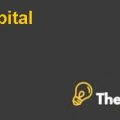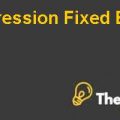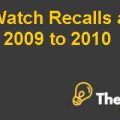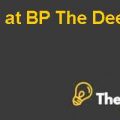
Financial Ratio and comparison analysis
The financial performance of PepsiCo will be evaluated and compared to Coca Cola Enterprise.
Trend Analysis
Liquidity
The liquidity ratio help evaluate the performance of a company in maintaining its most liquid items.
The current ratio (Figure 1) of PepsiCo had been improving since 2011 and had seen a slight fall in the last year. PepsiCo had been outperforming Coca Cola since 2012 and had been able maintain its working capital in a better way. Pepsi is in a better position pay-off its current debts with the current liabilities.
Figure 1: Current Ratio
The same trend had been followed in the quick ratios (figure 2) with Pepsi performing slightly better than the Coco Cola. The quick ratios are presenting a stable outlook of for the last couple of years. It signifies that Pepsi will be able to pay-off its debts without considering the less liquid items like inventory and prepayments.
Figure 2: Quick Ratio
Asset Management ratios
Inventory turnover ratio for the PepsiCo has been improving since 2010 but it has not been able to utilise the inventory efficiently. Coca Cola has outperformed Pepsi throughout this period quite significantly. However, Pepsi has been reducing the gap and trying manage inventory more efficiently. Figure 3 shows that the efforts are being put-in and the performance has improved in the recent years.
Figure 3: Inventory turnover ratio
Additionally, PepsiCo had been able to manage its receivables efficiently with year end receivables maintained under 40 days of sales. It has been improving in this regard and has been able to reduce it down to 36 days in 2014. Comparatively, Coca Cola had high DSO of around seventy (70) days.
Figure 4: Days Sales Outstanding (DSO)
Both the companies have been able to utilise their fixed assets to generate revenues at the same level and had improved in the last five years (Refer Figure 5). Asset Turnover ratio has also been maintained at over 0.2 by both companies.
Figure 5: Fixed Asset Turnover
2.1.3. Debt Management ratio
The debt ratio (Figure 6) of Coca Cola has been increasing over the period. It indicates that a larger proportion of Coca Cola’s assets are indirectly owned by the debtors. PepsiCo’s performance in this matter had been almost constant, but has overall performed better than Coca Cola. Both the companies have high financial leverage should try to reduce the debt ratio to an acceptable level.
Figure 6: Debt Ratio
The debt to equity ratios (Figure 7) had also been following a similar trend to that of debt ratio. PepsiCo has been trying to maintain its debt to equity ratio, while Coca Cola had been increase its debt. This shows that the new project or assets are being financed through the external debt. A debt-to-equity ratio of 2.762 for Coca Cola in 2014 is significantly high.
Figure 7: Debt-to-Equity Ratio
Similarly, the higher debt has resulted in higher pressure on the earnings of Coca Cola, due to the increasing interest payments. On the other hand, PepsiCo improved slightly since 2010 and had been able to increase the times interest earned (figure 8). This is also in-line with the increasing debt ratio of Coca Cola and Pepsi maintaining its debt ratio.
Figure 8: Time Interest Earned Ratio
2.1.4. Profitability Ratios
PepsiCo has outperformed Coca Cola in terms of both Gross profit margins and operating profit margin as well (Figure 9). PepsiCo has significantly higher gross profit margins maintained above 52% and operating profits margins at around 14%. This indicates that PepsiCo is able to manage its expenses comparatively better than Coca Cola.
Figure 9: Gross Profit Margin and Operating Profit Margin
The return on assets (Figure 10) of Pepsi has been significantly higher than that of Coca Cola. The return generated form assets had been maintained at around 2.1-2.3% by Pepsi, while it has been volatile for Coca Cola with a slight improvement in performance in 2014...................
This is just a sample partial case solution. Please place the order on the website to order your own originally done case solution.












